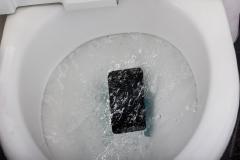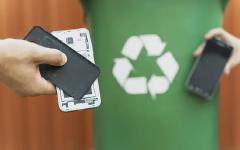Categories
Could changing your mobile habits help the planet?
7 minute read
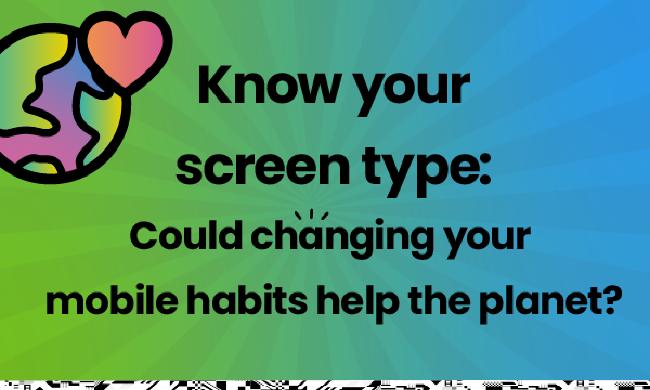
Are you trying to live a more sustainable lifestyle and want to be more mindful about using your phone?
Well, understanding your ‘screen type’ could help you save energy when you use your phone and be the simple start you need to adopt greener mobile habits.
Are you a High-Scroller, a White Water Rafter, or a Chatty Chatty Spam-Spam? Find out your screen type and see how a few small changes in your mobile habits can make a big difference.
1. The White Water Rafter

Looks like: A knackered commuter. 17:35, Waterloo to Winchester via Woking. Phone propped up on a tray table. Streaming. What is it today? Ahh yes. Yet another episode of that show they’re binge-watching. The hour-long trip home begins.
Some people stream, but these folk ‘flow’. While you dip your toes into the Netflix pool now ‘n’ then, the White Water Rafter jumps head-first down a waterfall of content into the depths of a video vortex. YouTube. Amazon. Disney. They’ll watch anything to pass the time.
All that matters is these streaming addicts have a constant supply of their favourite shows and movies. They’re not just streamers, they’re gunning it down the white-water rapids.
Why it’s important: Streaming content uses more energy than you might realise. And energy consumption produces CO2 into our atmosphere.
Storing, processing and transferring video content all requires a constant stream of energy from massive data centres. Plus, there’s additional energy used by your mobile provider to send you the signal to keep streaming. And don’t forget your phone’s battery, which will drain quicker the more you watch, meaning you’ll need to use more energy to charge it again.
How to go greener: Honestly, the most sustainable way would be to shut your phone off. Or at least, stop watching videos on your commute. If you need some form of entertainment, perhaps a good old fashioned book could work?
But we know that might not work for some people. Commuting is a pain already, without having to carry an extra item around. So if you do enjoy a good read, but don’t want to lug around a book, using your phone as an e-reader is more sustainable than streaming.
Or if you really ‘need’ to watch something on your journey, try lowering the quality of the stream and your screen’s brightness. This will help (even a little) with the energy drain from streaming servers and on your phone’s battery.
Most streaming services let you choose the quality of your video content. You really don’t need to watch a show in 4K or 1080p on your phone; the lowest quality settings will be good enough to watch. Plus it’ll help save a little on your data plan.
But it pays to mix things up now and then. And, who knows, perhaps you’ll discover other forms of content you love just as much as streaming?
2. The High-Scroller

Looks like: A finger, flicking rhythmically, while behind it a never-ending stream of social media content goes scrolling, and scrolling, and scrolling, and scrolling by.
The High-Scroller is social media incarnate. Anytime. Anyplace. The High-Scroller can’t help themselves. One cheeky glance quickly leads to hours and hours of scrolling, swiping, liking, commenting and posting.
Why it’s important: Much like streaming, social media relies on big data centres to hold and supply you with the juicy content you’re consuming.
It’s fair to say that scrolling on Facebook or Instagram might not use as much energy as watching a show from Netflix. But with the rise in popularity of more digestible video content, like with Snapchat and TikTok, the energy consumption from social platforms is on the rise.
But it’s not just the energy consumption and CO2 produced that’s causing a problem.
Scientists have researched the connection between social media and the dopamine centres in our brains. What they’ve found is that scrolling social media has more or less the same effect as eating a sugary sweet: it gives you a little buzz.
That’s why you keep going back, even after you’ve seen everything you had to see. It’s addictive.
How to go greener: The trick is to treat social media exactly like a sweetie: make it a reward.
Rather than checking it throughout the day, try to save your social media use for when you’ve finished everything else you had to do. That way, you’ll savour it even more. And you’ll probably find that you’re spending less time and energy each day, but still getting the digital treat you deserve.
3. Chatty Chatty Spam-Spam
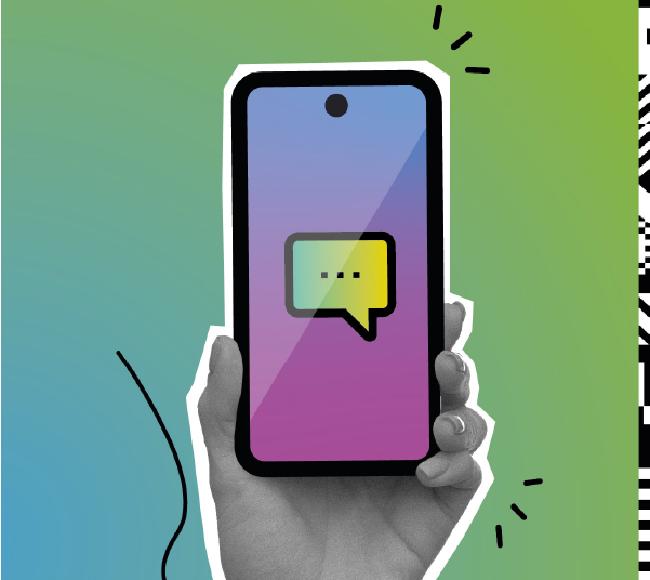
Looks like: If you’re a Chatty Chatty Spam Spam you’re a social butterfly, someone who loves to stay connected to your friends digitally.
If you’re not dropping memes or firing up conversations in your group chat, you’re on a video call with your besties. If something big’s happening in the news, you’re the first of your friends out there with your hot take.
It’s not unusual for a call to take you into the late hours of the night. You’re having fun with your friends, even if you’re in different locations. I mean, what are phones for if not connecting people?
Why it’s important: There’s nothing wrong with being a social butterfly. And if you’re the glue that keeps your friend group together, that’s awesome.
But endless video calls and using Internet-based messaging apps, isn’t the best thing for the environment, or your phone’s battery.
How to go greener: It’s time to live it up like it’s 2006. Believe it or not, switching back to SMS and voice calls (even occasionally) can benefit the environment.
Traditional phone calls and text messages don’t require the use of data centres, or transferring information across the world. They use local connections with your mobile operator’s towers and don’t require anywhere near as much energy usage as online services.
We’re not saying to stop sending memes or cancel the video calls altogether. But if you really don’t need to use an app to connect, switch back to a classic phone call or text. It’s worth it.
4. The “Let Me Look That Up”
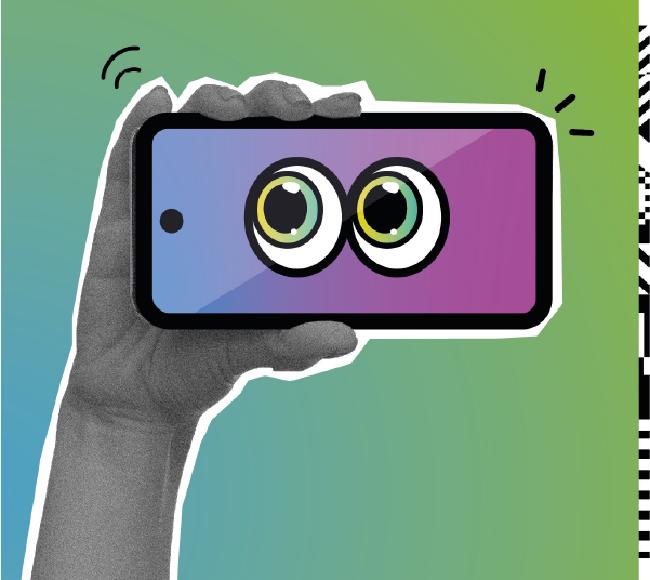
Looks like: This person likes to be ‘in the know’. Curious and hungry for information, they can’t take “I don’t know” for an answer. Before you’ve even finished your sentence, they’re online, searching for the information.
These folk enjoy interacting with a wide variety of people. They’re great conversationalists and love to engage other people in debates.
But occasionally, even their encyclopaedic knowledge will inevitably hit a stumbling block. And when they can’t recall that one ‘smoking gun’ stat, their hands reach for their pocket as those five words linger in the air: “Let me look that up.”
Why it’s important: Again, everything we do online requires energy consumption, not just in our homes, but through servers and data centres around the world. The more data we consume, the more energy is used and CO2 produced.
How to go greener: Well there’s good news here. You don’t need to change your habits so much as look into new providers for your Internet needs.
If you need answers to every question that floats into your brain right there and then, or if you’re simply the kind of person who lives for a debate, how about trying a more sustainable search engine?
That’s right. There are now some very cool environmentally-friendly search engine companies, who are helping to offset the carbon footprint on your searches.
For example, Ecosia plants trees for every search made, and produces 200% of its energy through renewable sources. Yes it produces twice the amount of energy needed for its searches, sustainably.
And there are more options out there, like Gexsi, which donates funds to climate change and marine conservation. Or Qwant, which uses 100% renewable energy for its data centres.
So, there’s no need to stop searching. After all, knowledge is good for us. But if you’re going to do it several times a day, why not use a search engine that makes a positive impact?
Small changes can make a difference
Getting in touch with your smartphone habits is the first step to making a difference.
And if you like these tips, why not share this article with your friends? If you can make another dozen people mindful of their smartphone habits, perhaps you can create a big impact between you.
Got any more tips? Be sure to add your thoughts and tips over on our community thread.
Looking for even more tips and advice to be more sustainable in 2022? Find out more in the giffgaff blog.
